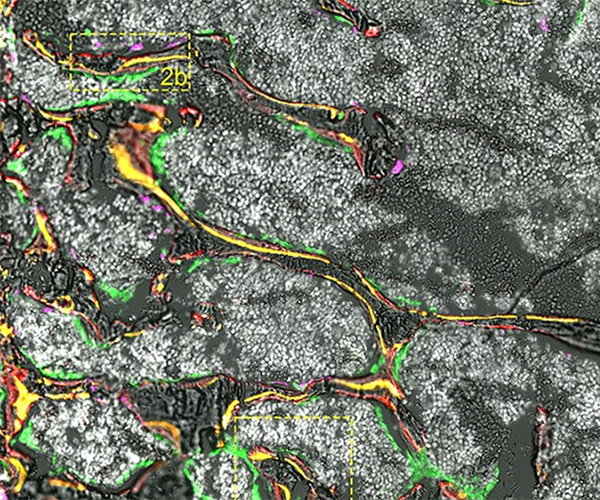
Section of mouse vertebrae with osteoblasts in green and osteoclasts in magenta. Yellow and orange staining mark bone mineralization fronts four days apart, indicating the mineral apposition rate.
Credit: Leikin Lab
Cooperation between bone-building cells, called osteoblasts, and bone-resorbing cells, called osteoclasts, helps maintain healthy bones. Researchers and clinicians often use a technique called bone histomorphometry to analyze the activity of these bone cells, as well as the architecture and growth of bone tissue. However, it can be challenging for an expert using this technique to properly identify osteoblasts and osteoclasts based on cellular appearance in traditionally stained histological sections.
- The Leikin Lab developed and optimized a new method called RNA-based histomorphometry. This technique involves staining sections of bone tissue for RNA transcripts of key marker genes—Col1a1 for osteoblasts and Ctsk for osteoclasts—to unambiguously identify the two cell types. Because this approach can be fully automated, it eliminates the need for subjective identification of cell types.
- RNA-based histomorphometry was more accurate and yielded more reproducible results than traditional histomorphometry analysis when applied to a mouse model of osteogenesis imperfecta, a heritable disorder causing bone fragility. The findings suggest that the higher accuracy of RNA-based histomorphometry may lead to insights into a puzzling feature of osteogenesis imperfecta—improvements in bone density after puberty.
- RNA-based histomorphometry also offers potential for clinical use, although further evaluation and optimization are needed. The scientists demonstrated its application to bone samples from a person with McCune-Albright Syndrome, a rare disorder affecting the bones, skin, and endocrine system.
Reference
Makareeva E, Sousa M, Kent T, de Castro LF, Collins MT, Leikin S. RNA-based bone histomorphometry: method and its application to explaining postpubertal bone gain in a G610C mouse model of osteogenesis imperfecta. J Bone Miner Res DOI: 10.1093/jbmr/zjad004 (2024)
Learn more about the Bone and Matrix Biology in Development and Disease group: https://www.nichd.nih.gov/about/org/dir/affinity-groups/BMBDD
 BACK TO TOP
BACK TO TOP